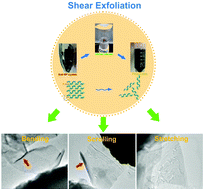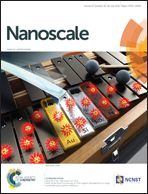In situ TEM visualization of superior nanomechanical flexibility of shear-exfoliated phosphorene†
Abstract
Recently discovered atomically thin black phosphorus (called phosphorene) holds great promise for applications in flexible nanoelectronic devices. Experimentally identifying and characterizing nanomechanical properties of phosphorene are challenging, but also potentially rewarding. This work combines for the first time in situ transmission electron microscopy (TEM) imaging and an in situ micro-manipulation system to directly visualize the nanomechanical behaviour of individual phosphorene nanoflakes. We demonstrate that the phosphorene nanoflakes can be easily bent, scrolled, and stretched, showing remarkable mechanical flexibility rather than fracturing. An out-of-plane plate-like bending mechanism and in-plane tensile strain of up to 34% were observed. Moreover, a facile liquid-phase shear exfoliation route has been developed to produce such mono-layer and few-layer phosphorene nanoflakes in organic solvents using only a household kitchen blender. The effects of surface tensions of the applied solvents on the ratio of average length and thickness (L/T) of the nanoflakes were studied systematically. The results reported here will pave the way for potential industrial-scale applications of flexible phosphorene nanoelectronic devices.


 Please wait while we load your content...
Please wait while we load your content...